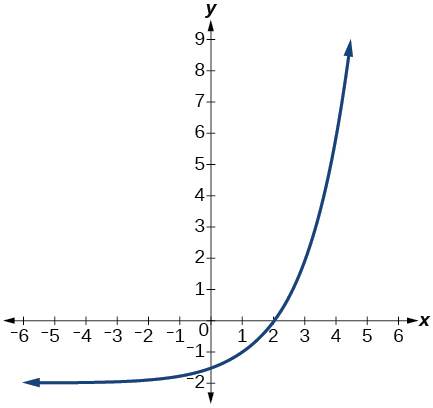6.2E : Graphiques des fonctions exponentielles (exercices)
- Page ID
- 195670
\( \newcommand{\vecs}[1]{\overset { \scriptstyle \rightharpoonup} {\mathbf{#1}} } \) \( \newcommand{\vecd}[1]{\overset{-\!-\!\rightharpoonup}{\vphantom{a}\smash {#1}}} \)\(\newcommand{\id}{\mathrm{id}}\) \( \newcommand{\Span}{\mathrm{span}}\) \( \newcommand{\kernel}{\mathrm{null}\,}\) \( \newcommand{\range}{\mathrm{range}\,}\) \( \newcommand{\RealPart}{\mathrm{Re}}\) \( \newcommand{\ImaginaryPart}{\mathrm{Im}}\) \( \newcommand{\Argument}{\mathrm{Arg}}\) \( \newcommand{\norm}[1]{\| #1 \|}\) \( \newcommand{\inner}[2]{\langle #1, #2 \rangle}\) \( \newcommand{\Span}{\mathrm{span}}\) \(\newcommand{\id}{\mathrm{id}}\) \( \newcommand{\Span}{\mathrm{span}}\) \( \newcommand{\kernel}{\mathrm{null}\,}\) \( \newcommand{\range}{\mathrm{range}\,}\) \( \newcommand{\RealPart}{\mathrm{Re}}\) \( \newcommand{\ImaginaryPart}{\mathrm{Im}}\) \( \newcommand{\Argument}{\mathrm{Arg}}\) \( \newcommand{\norm}[1]{\| #1 \|}\) \( \newcommand{\inner}[2]{\langle #1, #2 \rangle}\) \( \newcommand{\Span}{\mathrm{span}}\)\(\newcommand{\AA}{\unicode[.8,0]{x212B}}\)
9. Tracez la fonction\(f(x)=3.5(2)^{x}\). Indiquez le domaine et la plage et donnez l'\(y\)option -intercept.
10. Tracez la fonction\(f(x)=4\left(\frac{1}{8}\right)^{x}\) et sa réflexion autour de\(y\) l'axe -sur les mêmes axes, et donnez l'\(y\)intersection.
11. Le graphique de\(f(x)=6.5^{x}\) est reflété autour de\(y\) l'axe et étiré verticalement par un facteur de\(7 .\) Quelle est l'équation de la nouvelle fonction,\(g(x) ?\) indique son\(y\) intersection, son domaine et sa plage.
12. Le graphique ci-dessous montre les transformations du graphique de\(f(x)=2^{x} .\) Quelle est l'équation de la transformation ?

Graphique 1


